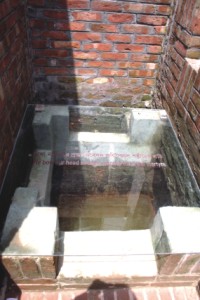| Event
Remembering the Martyrs
Fahim Razzaq
 |
The well where bodies of the victims were dumped. |
It happened more than three decades ago but the echoes of war haunt us yet again! Sadly even now a lot of us still have an unclear picture of how Bangladesh came to be, how many gave their lives to shape our country. This may be about to change because of a memorial in remembrance of the martyrs of ’71.
Inaugurated on June 21, Jalladkhana Killing Field Memorial is the result of an excavation in the year 1999 by the Muktijuddho Museum under the direction of Akku Chowdhury, a trustee of the Museum, along with the support of the Bangladesh Army. The project succeeded in recovering 70 skulls and 5392 bones of men, women and children. They also found an assortment of personal belongings of those who were slaughtered during the Liberation War. The Muktijuddho Museum took up the challenge of preserving the location and building a memorial at the spot; marking the heinous crimes committed against our countrymen during the Liberation War. The Jalladkhana Killing Field Memorial has been built in remembrance of the martyred individuals.
The memorial is a reminder of the inhuman acts of 1971, one of them being the indiscriminate killing of civilians by the Pakistani army and its string of collaborators at a deserted WASA pump-house. The Pak Army chose the well in the pump-house to dispose of the bodies, thus the slaughterhouse got its name; Jalladkhana or Butcher’s Den. Mofidul Huq and Robiul Hossain also trustees of the Muktijuddho Museum were also instrumental in making the memorial a reality.
The countless names found from just six locations written on the gravestone-like pillars in the triangular courtyard gives disturbing proof of the extent of the massacre that has left behind a lifetime of grief to the families of the victims.
 |
The Jalladkhana Killing Field Memorial. |
Beside the pillars are placed plates of ‘earth’ from each of the six killing sites, a symbolic memorial to show respect to all the martyres. A large wall in the middle contains a mural by the famous artist Rafiqun Nabi called ‘Jibon Obinoshshor”. The gravestone-like pillars also contain a list of other discovered major mass killing sites of the 20th century from places like Sudan and Armenia - depicting what has happened and is continuing to happen in these countries. Two black stones can be found before entering the pump-house; one contains the slogan –STOP GENOCIDE- engraved in red, named after the famous documentary by the martyr filmmaker Zahir Raihan, who disappeared in 1971 while searching for his martyred brother Shahidullah Kaiser. The other contains the slogan entitled ‘1971 Jalladkhana Memorial Site’ and it reads; “The blood-filled soil are witness, the moonlit skies are witness. We will never forget the fallen brave. We won’t forget anything.” The inexplicable grief that one is engulfed with at the mere sight of these words is something perhaps only a Bangladeshi can experience. It is inextricably linked to what it means to be a Bangladeshi.
 |
The infamous pump-house room where the killings took place. |
Next, lies the cursed pump-house room where the killings took place all those years ago. The low doorway has a bell hung at the entrance; they say that the sound of the bell will take you back to one of the horrendous chapters in our history. On top of the doorway a sign reads in five different languages, ‘What happened here?’ Upon entering the pump-house another notice explains how the memorial came to be. There is the pit where the bodies were dumped and last of all some personal belongings are displayed in a glass frame.
As I moved along to the other room I the face of Lokman Hussain Liton, son of Dr. Zainuddin who was killed in the slaughterhouse, comes to my mind. Lokman Hussain had been present at the inauguration and as he began to talk, it was clear that he was revisiting painful memories. He barely managed to maintain his composure and nearly wept out loud whilst talking over the microphone. It occurred to me that he was merely a member of one family amongst countless others who had lost someone, be it a father, a mother, a brother, a son, a daughter or a sister during that turbulent time of our history. There are so many of them out there and the thought that kept coming back to me was, “How much pain did they have to endure? How much suffering did it take to win our rights that we take so granted for today, the right to call ourselves Bangladeshi?”
In the other room was a list of the thousands who lost their lives along with a table to write any information of other individuals who had been martyred but not mentioned in the list. The Muktijuddho Museum has made an appeal for people to come forward and help complete the list; they call for the nation’s youth to visit the memorial and keep our history and heritage alive.
It is our duty as the citizens of Bangladesh to commemorate those who fought in the war, to honour those who have lost their lives fighting or were brutally killed for being patriotic. It is our duty to our motherland to remember her sons and daughters who died so that she could live on; it is our most sacred responsibility to keep their memories alive.
Copyright
(R) thedailystar.net 2007 |
